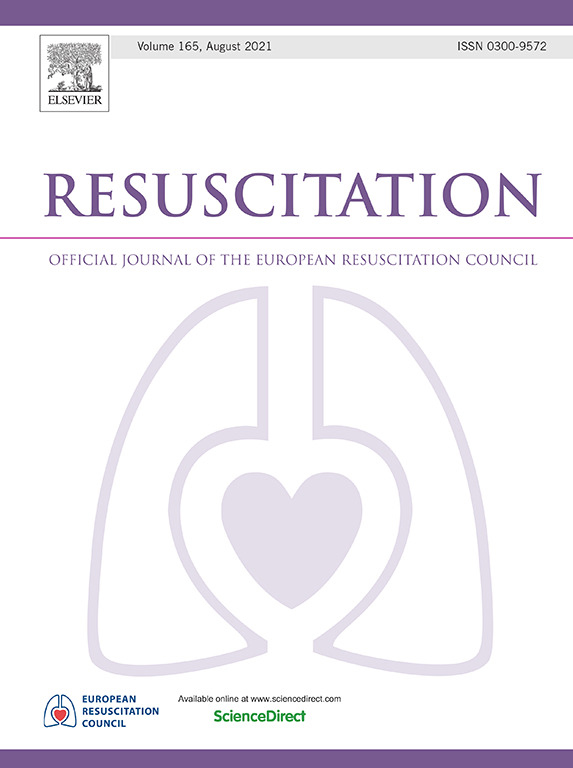Clinical state transitions in shock-refractory ventricular fibrillation: an observational study
IF 6.5
1区 医学
Q1 CRITICAL CARE MEDICINE
引用次数: 0
Abstract
Aim
To characterise clinical state transitions in patients with out-of-hospital cardiac arrest (OHCA) from refractory ventricular fibrillation or pulseless ventricular tachycardia (VF/pVT) and their association with clinical outcomes.
Methods
We conducted an exploratory observational study of refractory VF/pVT OHCA cases treated by emergency medical services (EMS) between 2010 and 2019 in Victoria, Australia. Refractory VF/pVT OHCA was defined as initial VF/pVT arrests with at least three consecutive defibrillation attempts. Adjusted logistic regression analyses were conducted to examine predictors of clinical state transitions and secondary VF/pVT.
Results
3,018 cases met the inclusion criteria. Of these, 35.8% transitioned into ROSC, 36.6% transitioned into PEA, and 17.5% transitioned into asystole. secondary VF/pVT occurred in 41.7% of patients. The proportion of patients discharged alive was significantly higher in the ROSC group (60.0%) compared to the PEA (11.3%) and asystole groups (3.2%). Predictors of achieving ROSC included being witnessed by bystanders or EMS and bystander CPR. Predictors of secondary VF/pVT included male gender, increased resuscitation duration and administering adrenaline prior to the first clinical state transition. Transitioning into ROSC was associated with reduced odds of secondary VF/pVT, while transitioning into PEA increased the odds of secondary VF/pVT.
Conclusion
Understanding clinical state transitions during the resuscitation of refractory VF/pVT patients may allow for the development of tailored treatment strategies.
休克难治性心室颤动的临床状态转变:一项观察性研究
目的探讨院外心脏骤停(OHCA)难治性室颤或无脉性室性心动过速(VF/pVT)患者的临床状态转变及其与临床结局的关系。MethodsWe进行了一次探索性的观察研究耐火材料VF / pVT OHCA病例治疗紧急医疗服务(EMS)在2010年和2019年之间在维多利亚,澳大利亚。难治性VF/pVT OHCA定义为初始VF/pVT骤停且至少连续三次除颤尝试。采用调整后的logistic回归分析来检验临床状态转变和继发性VF/pVT的预测因素。结果3018例符合纳入标准。其中35.8%转变为ROSC, 36.6%转变为PEA, 17.5%转变为心脏骤停。继发性VF/pVT发生率为41.7%。ROSC组患者存活出院的比例(60.0%)明显高于PEA组(11.3%)和asystle组(3.2%)。达到ROSC的预测因子包括旁观者或EMS和旁观者CPR的目击。继发性VF/pVT的预测因素包括男性、复苏时间延长和在首次临床状态转变前给予肾上腺素。过渡到ROSC与继发VF/pVT的几率降低有关,而过渡到PEA则增加了继发VF/pVT的几率。结论了解难治性VF/pVT患者复苏过程中的临床状态转变有助于制定针对性的治疗策略。
本文章由计算机程序翻译,如有差异,请以英文原文为准。
求助全文
约1分钟内获得全文
求助全文
来源期刊

Resuscitation
医学-急救医学
CiteScore
12.00
自引率
18.50%
发文量
556
审稿时长
21 days
期刊介绍:
Resuscitation is a monthly international and interdisciplinary medical journal. The papers published deal with the aetiology, pathophysiology and prevention of cardiac arrest, resuscitation training, clinical resuscitation, and experimental resuscitation research, although papers relating to animal studies will be published only if they are of exceptional interest and related directly to clinical cardiopulmonary resuscitation. Papers relating to trauma are published occasionally but the majority of these concern traumatic cardiac arrest.
 求助内容:
求助内容: 应助结果提醒方式:
应助结果提醒方式:


